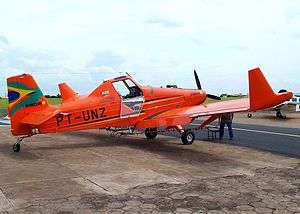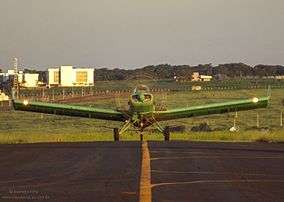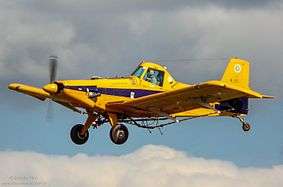Embraer EMB 202 Ipanema
| EMB 202 Ipanema | |
|---|---|
 | |
| Role | Agricultural aircraft |
| National origin | Brazil |
| Manufacturer | Embraer |
| First flight | 1970 |
| Introduction | December, 1971 |
| Status | Active |
| Produced | 1969- |
| Number built | 1200 as of 2012[1] |
| Unit cost | |
The Embraer EMB 202 Ipanema is a Brazilian agricultural aircraft used for aerial application, particularly crop dusting. It is produced by Indústria Aeronáutica Neiva, a subsidiary of Embraer located in Botucatu, Brazil. The latest version of this aircraft is the first ethanol-powered fixed-wing aircraft,[2] which could give it an economical advantage over the gasoline version. The aircraft is widely employed in Brazil, having market share of about 80%, and the 1,000th delivery was completed on 15 March 2005. Besides aircraft, alcohol-conversion kits for gasoline-powered Ipanemas are also sold.
Development
In the 1960s, the development of a Brazilian agriculture aircraft was motivated by the expansion of the agricultural products market, specifically soybean and sugar cane. During this time, the Ipanema aircraft was developed by engineers of the Aeronautics Technological Institute (ITA) on the Ipanema Farm, located in Sorocaba.[3]
The first version of the aircraft, the EMB-200, made its first flight in 1970 and was certified in December 1971. The aircraft was equipped with a 260 hp (190 kW) piston engine. Series production started in 1972 by Embraer. In September 1974, the EMB-201 was introduced, including many improvements such as a 300 hp (220 kW) engine, new propeller, new wings and increased capacity.
In 1982, the production of Ipanema was transferred to Indústria Aeronáutica Neiva, recently acquired by Embraer. In 1992, a new model, called EMB-202 or Ipanemão( big Ipanema), was released. The new aircraft had improvements on aerodynamics, a 40% greater capacity, and optional, modern equipment for electrostatic aerial application.
In the following years, Neiva made significant improvements to the aircraft, such as adding winglets to the wingtips, adding an air conditioning system to the cabin, lowering the position of the wings, decreasing resistance and reducing the weight of the exhaust system.
Since ethanol is largely available in Brazil, costing only about 25-30% as much as aviation gasoline, many Brazilian farmers have attempted to fuel gasoline-powered Ipanemas with alcohol, with varying degrees of success. The result of this was the development of an alcohol-powered Ipanema, which was certified by the Brazilian General Command for Aerospace Technology (CTA) on 19 October 2004. The alcohol fuelled Ipanema engine also has 20% lower maintenance and operational costs.
In 2015 an Ipanema with improved winglets was presented on the Agrishow agricultural exposition. The new winglets, designed by the department of Aeronautical Engineering of the University of São Paulo's São Carlos School of Engineering, increased the performance of the aircraft by 20%.[4]
Variants
In parentheses are shown certification dates.
- EMB-200 (December 1971) with a 260 HP Lycoming engine, Mc Cauley propeller and 550 kg capacity.
- EMB-200A (December 1973) similar to EMB-200 with Hartzell propeller and an improved engine.
- EMB-201 (September 1974) with 300 HP Lycoming engine, Hartzell propeller and 750 kg capacity, plus improved aerodynamics.
- EMB-201A (April 1977) similar to EMB-201 with a new panel, controls and wings.
- EMB-201R Single-seat glider-tug aircraft for the Brazilian Air Force. Three were built for the Air Force Academy gliding club. Brazilian Air Force designation U-19.
- EMB-202 (May 1991) with 300 HP Lycoming engine, Hartzell propeller and 950 kg capacity.
- EMB-202A (October 2004) with 320 HP Lycoming engine, using ethanol fuel and a propeller with better performance, lower maintenance and lower operational costs.
- EMB-203 (November 2015) with 320 HP Lycoming engine, certificate in 2015, has a wingspan of 13.3 m and its winglets redesigned, increasing control and improving the efficiency of spraying.[4]
Governmental operators
Specifications (EMB-202)


Data from Jane's All The World's Aircraft 2003–2004[5]
General characteristics
- Crew: 1 pilot
- Capacity: 950 litres (250 US gal; 210 imp gal) liquid or 750 kilograms (1,650 lb) dry chemicals
- Length: 7.43 m (24 ft 5 in) (tail up)
- Wingspan: 11.69 m (38 ft 4 in)
- Height: 2.20 m (7 ft 3 in) (tail down)
- Wing area: 19.94 m2 (214.6 sq ft)
- Aspect ratio: 6.9:1
- Empty weight: 1,020 kg (2,249 lb)
- Max takeoff weight: 1,800 kg (3,968 lb) (restricted category)
- Fuel capacity: 264 litres (70 US gal; 58 imp gal) usable fuel
- Powerplant: 1 × Textron Lycoming IO-540-K1J5D air-cooled flat-six, 224 kW (300 hp)
Performance
- Maximum speed: 230 km/h (143 mph; 124 kn)
- Cruise speed: 213 km/h (132 mph; 115 kn) (75% power)
- Stall speed: 92 km/h (57 mph; 50 kn) (power off)
- Never exceed speed: 272 km/h (169 mph; 147 kn)
- Range: 938 km (583 mi; 506 nmi)
- Service ceiling: 3,470 m (11,380 ft)
- Rate of climb: 4.7 m/s (930 ft/min)
- Take-off run to 15 m (50 ft): 332 metres (1,089 ft)
- Landing run from 15 m (50 ft): 412 metres (1,352 ft)
See also
- Aircraft of comparable role, configuration and era
- Grumman Ag Cat
- Ayres Thrush
- PAC Fletcher
- CallAir A-9
- Hongdu N-5
- Piper PA-25 Pawnee
- Piper PA-36 Pawnee Brave
References
- Notes
- ↑ "Embraer entrega 1200ª unidade do avião agrícola Ipanema" (in Portuguese). Reuters, 31 January 2012. Retrieved: 1 February 2012
- ↑ Unesco. (2010-01-01). UNESCO science report 2010 : the current status of science around the world. United Nations Educational, Scientific and Cultural Organization. p. 115. ISBN 9789231041327. OCLC 704352349.
- ↑ Embraer, Embraer Historical Center - Centro Histórico. "EMB 200 Ipanema - Centro Histórico Embraer". www.centrohistoricoembraer.com.br (in Portuguese). Retrieved 2017-05-12.
- 1 2 http://www.eesc.usp.br/portaleesc/index.php?option=com_content&view=article&id=2285%3Acomponente-desenvolvido-na-eesc-aumenta-em-20-o-desempenho-de-aeronave-agricola&catid=115&Itemid=164
- ↑ Jackson 2003, p. 31.
- Bibliography
- Jackson, Paul, ed. (2003). Jane's All The World's Aircraft 2003–2004. Coulsdon, UK: Jane's Information Group. ISBN 0-7106-2537-5.
- December 2005 issue, pg 60-61, Scientific American
- Embraer Press Release 2005/03/15 NEIVA DELIVERS 1000TH IPANEMA CROP DUSTER
- Embraer Press Release 2004/10/19 ETHANOL-FUELED IPANEMA CERTIFIED BY THE CTA
External links
| Wikimedia Commons has media related to Embraer Ipanema. |